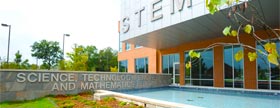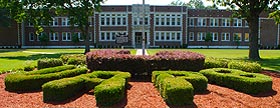Curriculum Description and Course Descriptions
The graduate program in computer science & technology will have two degree options for completion. (1) Thesis option, which will require 30 semester credit hours of graduate work (24 hours of coursework and 6 hours of graduate thesis approved by the advisory committee). The thesis may be some notable work on an appropriate research topic or area, as approved by the graduate advisory committee. (2) Project option, which will require 30 semester credit hours of graduate work (24 hours of coursework and 6 hours of graduate project approved by the advisory committee). The project may be some notable work on an appropriate research topic or area as approved by the graduate advisory committee.
Other graduation requirements will include:
- A 3.0 Cumulative GPA on a 4.0 scale.
- No course with a grade of “D” may be used to satisfy degree requirements.
- As many as 9 semester hours may be transferred from other schools, but credit will be given only for specific courses in the University of Arkansas at Pine Bluff’s computer science & technology graduate curriculum requirements.
- Credit will not be allowed for courses taken more than 5 years prior to the application for transfer to University of Arkansas at Pine Bluff.
- A maximum of 6 semester hours with a grade of “C” may be used to satisfy degree requirements.
Other General Degree Requirements
A master’s degree provides certification that the recipient is able to read, understand, apply and profit from the literature and opportunities in her/his field. All pertinent regulations of the graduate school apply. Listed below are regulations that are clarifications of, or additions to, those promulgated by the Graduate School.
Advisory Committee
Every master’s student will have an advisory committee consisting of a minimum of three members, one of whom will be a permanent, full-time computer science, or industrial technology or mathematical sciences faculty member. The other members may be from either within, or outside, the Mathematical & Computer Sciences or Industrial Technology departments in a related area of interest, who are capable of evaluating the work performed by the student.
Advisory Committee Formation
The student’s advisory committee must be formed by the student’s second semester enrolled in the program. The student is responsible for identifying, in consultation with his/her departmental chairperson, a faculty member who will chair her/his advisory committee. In consultation with the chairperson of the committee, the student is responsible for identifying two other computer science / math / industrial technology / faculty members who are willing to serve on her/his committee. At the discretion of the chairperson of the committee, the committee may include at most one member external to the UAPB faculty, i.e., either faculty from other universities or appropriate personnel from industry.
Also, at the discretion of the chairperson of the committee, the advisory committee may include more than three members. If desired, two members of the committee may serve as co-chairs of the committee. If a student is unable to identify a sufficient number of faculty who are suitable and willing to serve on her/his advisory committee, the student will be advised by the departmental chairperson that he/she should either change her/his area of research interests to more closely match those of the available faculty, or consider selecting another major. Failure to form a committee is cause for transfer to non-degree status. Further regulations concerning the membership, appointment and responsibilities of a student’s advisory committee are given in other sections of the graduate catalog.
Thesis/Comprehensive Examination
A candidate for a master’s degree in computer science & technology must submit a thesis in writing and orally present and defend the thesis to her/his advisory committee. The student will submit to their advisory committee by end of their second semester a thesis proposal as outlined below.
Thesis Proposal
A thesis proposal should be developed prior to the initiation of thesis research and submitted to their committee members for approval before end of their second full semester of enrollment. The proposal must include an Introduction, Literature Review, Methods, Results, Discussion and References section. The style of the thesis proposal will follow the ‘manuscript preparation’ guidelines for the Association for Computing Machinery (ACM) or Institute of Electrical and Electronics Engineers (IEEE) journals.
Thesis Presentation, Defense, and Submission
All students planning to defend their thesis will have an advisory committee meeting to determine if research is sufficient, all courses on the plan of study have been taken/successfully passed, and the thesis draft is in satisfactory condition for defense. The advisory committee also shall serve as the thesis defense committee. The entire advisory committee must be given sufficient time to review and approve the thesis for defense prior to scheduling the defense. The thesis will be presented to the public in a seminar format with the aid of computer presentation tools such as Microsoft PowerPoint.
The thesis defense must be scheduled and advertised two weeks before the intended presentation date. The student will give a 30~45 minute overview of their research and results followed by audience questions. The presentation and questions will last no longer than one to two hours. The meeting at which the thesis is presented, and defended also, serves as the student’s final oral comprehensive examination over any or all aspects of the student’s master’s program.
Upon completion of the thesis defense, the student will be excused while the advisory committee determines the outcome of the defense (Pass or Fail). Passing the thesis defense requires majority committee agreement. The advisory committee may elect to pass a student with conditions such as recommending minor changes to their thesis. The student will be notified immediately following the thesis defense of their success or failure and the changes the must be made before the thesis will be given final written approval by the committee. The chair of the student’s advisory committee will provide written notification of the defense outcome to the student.
In the event that the student fails the thesis defense, the student may elect to defend a second and final time at least 30~60 days after the initial thesis defense. In the event that the student fails the second defense, the student will be dismissed from the program.
On the form on which the chairperson of the student’s advisory committee reports the results of the thesis defense, the chairperson also reports the results of the comprehensive examination, including a brief synopsis of the examination. These signatures indicate that all proposed research is satisfactory and all suggested changes have been satisfied and that the thesis is complete.
Non-thesis Project Option
Students may be able to enroll in a non-thesis project option for the degree requiring 24 hours of course work, 6 hours of project work leading to a 30 credit hour requirement for graduation. Students choosing this option will have to go through a final presentation in the project related area. The defense committee is to be chosen by the student in consultation with the chairperson based upon the project work chosen. Each student must prepare and deliver the following document to members of their committee who are going to attend the presentation and to the project advisor, at least two week before the presentation is scheduled.
The document must include the following:
- Problem specification/definition (1-3 pages)
- System/software architecture, if applicable (1-2 pages)
- Requirement Specification [software and hardware, if applicable] (6-20 pages)
- Design specification (6-20 pages)
- Test cases and test results [if any software has been developed] (5-10 pages)
- Source code, if any software has been developed (as many pages as needed)
Upon completion of the project defense, the student will be excused while the advisory committee determines the outcome of the defense (Pass or Fail). Passing the project defense requires majority committee agreement. The advisory committee may elect to pass a student with conditions such as recommending minor changes to their project. The student will be notified immediately following the project defense of their success or failure and the changes the must be made before the project will be given final written approval by the committee. The chair of the student’s advisory committee will provide written notification of the defense outcome to the student.




